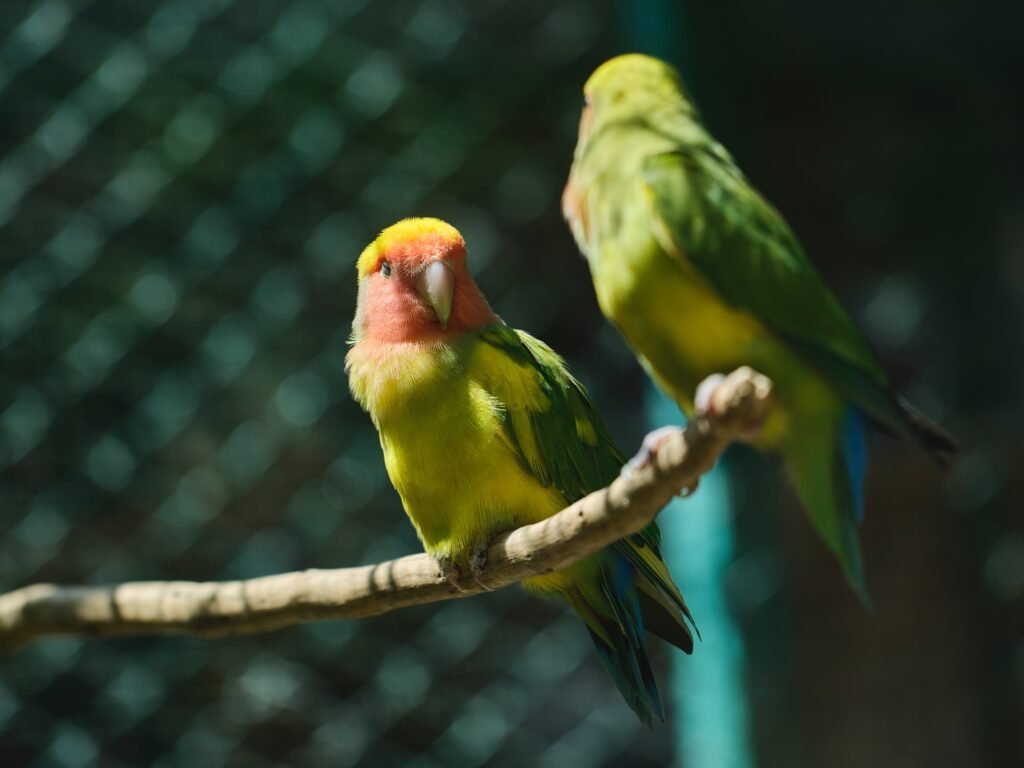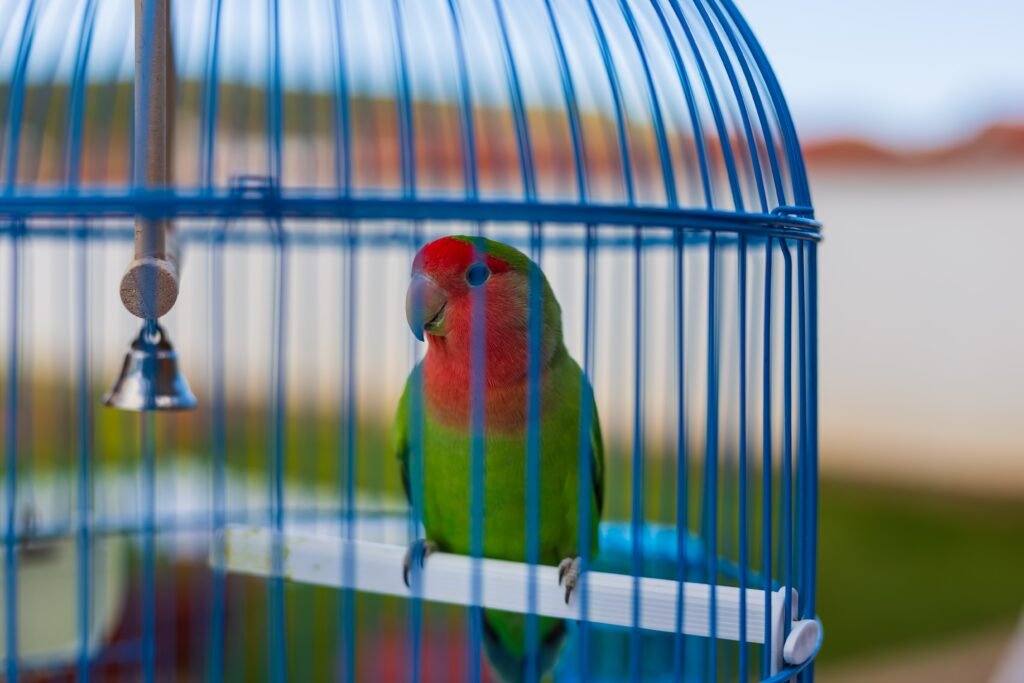Lovebirds are delightful and entertaining pets that bring joy and happiness to any household. Their lively and playful nature is a significant part of their charm, making them popular among bird enthusiasts and pet owners. This article will explore the various aspects of lovebirds’ playfulness, including their behavior, toys, and activities to keep them entertained and the importance of social interaction for their overall well-being.
Understanding Lovebirds’ Playful Behavior
Lovebirds are highly social birds that thrive on interaction and play. They are known for their playful antics, from hopping and dancing to hanging upside down and exploring their surroundings. Their active and curious nature makes them excellent companions and ensures there is never a dull moment when you have a lovebird as a pet.
One of the most endearing behaviors of lovebirds is their habit of playing with objects and toys in their environment. They enjoy chewing on various materials, such as wooden blocks or ropes, and tossing small toys with their beaks. Providing them with various safe and interactive toys is essential to keep them mentally stimulated and entertained.
Lovebirds also engage in playful behaviors to establish and maintain social bonds with their mates or human companions. They often engage in mutual preening, grooming each other’s feathers as a form of affection and bonding. This behavior reinforces their social structure and strengthens their relationships.
Moreover, lovebirds are known for their vocalizations during play. They may chirp, whistle, or mimic sounds to communicate and express their excitement. This playful communication adds to the joy and liveliness of having lovebirds as pets.
Choosing the Right Toys for Lovebirds
When selecting toys for your lovebirds, it’s crucial to consider their safety and engagement value. Opt for toys made from bird-safe materials, such as untreated wood or natural fibers, to avoid potential harm. Toys with different textures, colors, and shapes can pique their curiosity and provide them with hours of entertainment.
- Swings and perches: Lovebirds enjoy swaying on swings and balancing on perches. Providing them with various perches of different sizes and textures will help keep their feet healthy and engaged. Consider adding swings with bells or mirrors to add an extra stimulation element.
- Foraging toys: Lovebirds are intelligent birds that enjoy problem-solving and exploring their surroundings. Foraging toys, such as puzzle feeders or treat-dispensing toys, can stimulate their mental abilities while rewarding them with tasty treats. Hide their favorite treats inside these toys to encourage them to engage and figure out how to retrieve the treats.
- Shreddable toys: Lovebirds have a natural inclination to chew and shred materials. Toys made from safe, chewable materials like palm leaves or paper can satisfy and entertain their chewing instinct. Introduce toys that can be torn apart, such as woven shredding toys, to provide them with a healthy outlet for their natural behaviors.
- Mirrors: Lovebirds are known to be highly social creatures. Mirrors can give them the illusion of having a companion, reducing their loneliness and boredom. Place a small mirror in their cage or attach it to a safe toy to give them a sense of company and engagement.
Fun Activities to Keep Lovebirds Happy
In addition to providing appropriate toys, engaging your lovebirds in fun activities is essential for their overall well-being. Here are some ideas to keep your lovebirds happy and entertained:
- Flight time: Lovebirds are agile fliers and enjoy stretching their wings. Allowing supervised flight time outside the cage in a safe and secure environment can provide them with much-needed exercise and mental stimulation. Create a bird-proofed space where they can spread their wings and fly around freely.
- Training sessions: Lovebirds are intelligent and can be trained to perform simple tricks or commands. Positive reinforcement training sessions can strengthen the bond between you and your lovebird while providing mental stimulation. Teach them to step onto your finger, wave their wings, or even play a small basketball game using a miniature hoop and ball.
- Social interaction: Lovebirds are highly social creatures that thrive on companionship. Interacting with them daily, such as talking, singing, or playing games, helps them feel loved and strengthens the bond with their human family. Set aside dedicated playtime where you engage in interactive activities with your lovebirds, such as teaching them to mimic sounds or sing with you.
- Exploration time: Lovebirds are curious by nature and enjoy exploring new places. Create a bird-safe exploration area outside their cage, such as a play gym or a designated space with toys and perches, where they can interact with their surroundings and satisfy their natural curiosity. Add branches, ladders, and tunnels to encourage climbing and exploring different textures.
The Importance of Social Interaction
Lovebirds thrive on social interaction with their human caregivers and other lovebird companions. Lack of proper socialization and attention can lead to feelings of loneliness, stress, and even behavioral problems. Spending quality time with your lovebirds every day is essential, providing them with the attention, love, and mental stimulation they need.
Regular social interaction helps build trust and strengthens the bond between you and your lovebirds. Talking to them in a soft, friendly tone and offering treats as rewards for good behavior can help create a positive association and reinforce desirable actions. Additionally, consider introducing your lovebirds to other friendly birds or supervised playdates to provide them with opportunities for socialization and companionship.
Conclusion
Lovebirds’ playfulness is one of their most enchanting qualities. Their lively and curious nature and the right toys and engaging activities can provide endless entertainment and happiness for the birds and their owners. By understanding their playful behavior, providing appropriate toys, and offering regular social interaction, you can ensure that your lovebirds lead fulfilling and joyful lives. So, embrace the vibrant and lively world of lovebirds and create a playful haven for these delightful companions!
FAQ
1. What do lovebirds display some playful behaviors?
Lovebirds display a range of playful behaviors, including hopping, dancing, hanging upside down, and exploring their surroundings. They also enjoy playing with objects and toys in their environment, such as chewing on wooden blocks or tossing small toys with their beaks.
2. What types of toys are suitable for lovebirds?
When choosing toys for lovebirds, it’s important to consider their safety and engagement value. Some suitable toys for lovebirds include swings and perches, foraging toys like puzzle feeders, shreddable toys made from safe materials like palm leaves or paper, and mirrors to provide them a sense of companionship.
3. What fun activities can keep lovebirds happy and entertained?
To keep lovebirds happy and entertained, you can provide them with flight time outside the cage in a safe environment, engage in training sessions to teach them tricks or commands, interact with them daily through talking, singing, or playing games, and create a bird-safe exploration area outside their cage for them to satisfy their curiosity.
4. Why is social interaction important for lovebirds?
Social interaction is crucial for lovebirds as they are highly social creatures. Lack of socialization and attention can lead to feelings of loneliness, stress, and behavioral problems. Regular social interaction with their human caregivers and other lovebird companions helps build trust, strengthens the bond, and provides mental stimulation for lovebirds.
.


